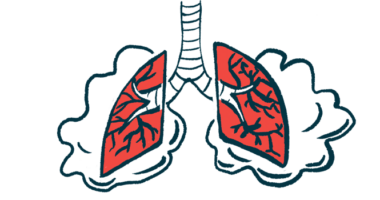New compound counters F508del mutation, boosts Trikafta’s effects
Work into molecule to aid protein function, synthesize with CFTR modulators

Scientists have synthesized a new compound that can boost the activity of the CFTR protein carrying the most common mutation that causes cystic fibrosis (CF).
In cell models, the compound was able to further increase the activity of approved CFTR modulators.
The compound’s development was described in the paper, “Innovative Strategy toward Mutant CFTR Rescue in Cystic Fibrosis: Design and Synthesis of Thiadiazole Inhibitors of the E3 Ligase RNF5,” published in the Journal of Medicinal Chemistry.
Compound suppresses activity of the RNF5 protein to rescue CFTR function
CF is caused by mutations in the gene that provides instructions for making the CFTR protein. Normally, this protein sits at the cell’s surface and helps to control the movement of water and salts in and out of cells. In CF, the protein is dysfunctional or entirely absent, leading to the production of the thick mucus that causes most disease symptoms.
F508del is the most common CF-causing mutation. It is present in around 80% of all CF patients, and the most common in people of European descent. The F508del mutation leads to the production of an unstable version of the CFTR protein, which is destroyed before it can reach the cell surface and begin working.
CFTR modulators are a recently developed class of therapies that bind to CFTR protein carrying specific mutations, helping to boost the protein’s functionality. Trikafta, a triple-combination of CFTR modulators, is approved in the U.S. for children as young as 2 who carry a copy of the F508del mutation, or another mutation that the therapy is known to work on.
Although treatments like Trikafta can increase the CFTR protein’s ability to work, studies have consistently shown that they don’t fully restore protein function to levels seen in people without CF. Researchers are looking for additional therapies able to further improve the rescue of CFTR function.
In this search, scientists have zeroed in on a protein called RNF5. This protein is a ubiquitin ligase — part of the molecular machinery that normally helps to dispose of misfolded proteins, including CFTR with the F508del mutation.
Previous studies suggested that suppressing RNF5 activity can increase the amount of F508del-CFTR on the surface of the cell, allowing the protein to function better.
While RNF5 has been validated as a potential treatment target in CF, actually finding a medication that can block this protein has proven challenging. In large part, this is because some oddities to the RNF5 protein’s molecular structure make it hard to design a drug that can stick to the protein. Recently, scientists identified a small molecule, referred to as inh-2, that is able to block RNF5.
Researchers in Italy took the inh-2 molecule, and designed and synthesized dozens of versions with small chemical variations. Their goal was to create a molecule that could optimally bind to the RNF5 protein.
CFTR modulators help the protein work, but they can’t fully restore its function
Through a battery of biochemical and cellular tests, the team identified one of these chemical variations, referred to as “analogue 16,” that was able to block RNF5 activity more effectively than any of the other versions, including the original inh-2 molecule.
Analogue 16 showed an ability to rescue CFTR activity in cells carrying the F508del mutation, boosting the CFTR protein’s function. When this compound was combined with Trikafta, the increase in CFTR activity was greater than with Trikafta alone.
“Co-treatment with [analogue] 16 significantly improved the F508del-CFTR rescue induced by the triple combination [Trikafta],” the scientists concluded.
Collectively, these findings support the idea that blocking RNF5 with a small molecule could be a viable treatment strategy for CF that can synergize with existing CFTR modulators, the researchers said. They now are working to further optimize analogue 16 to design a small molecule with similar RNF5-blocking activity, whose pharmacological properties are suitable for a medication given people.
The researchers noted that, theoretically, blocking RNF5 could be beneficial not only for patients with the F508del mutation, but also for those with mutations that don’t respond to available CFTR modulators like Trikafta.








